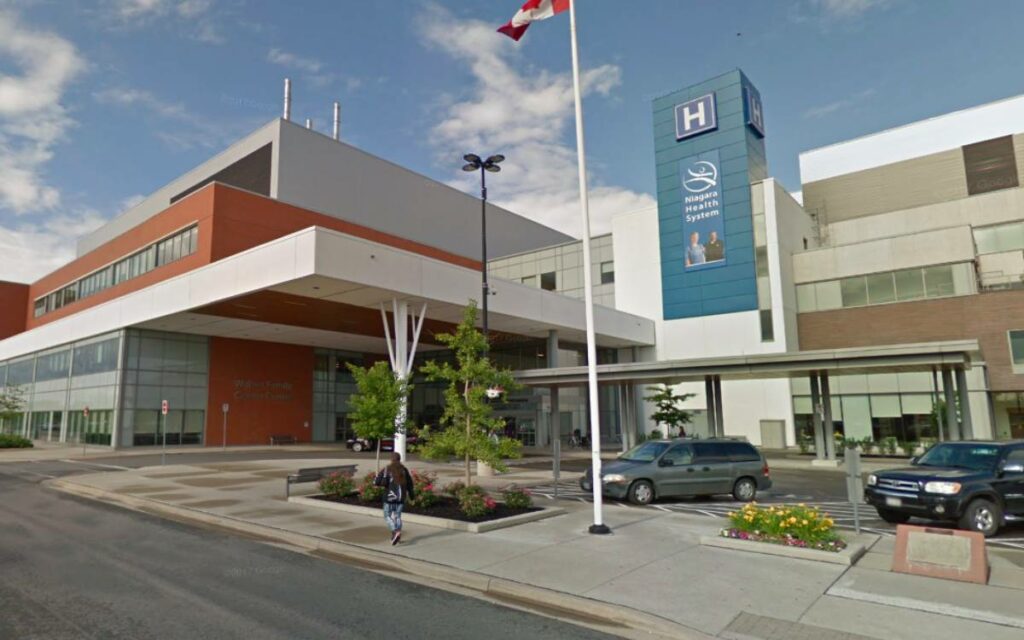
Niagara Health – St. Catharines Site. Photo credit: Google Maps
Despite last Monday issuing a press release and a widely circulated social media warning about the St. Catharines critical care units being over capacity, as late as Friday St. Catharines hospital was still accepting COVID-19 patients from other overwhelmed regions.
NHS CEO Lynn Guerriero issued a press release last Monday warning Niagara, “Our teams are working extremely hard to do everything possible to minimize the impact on patient care at Niagara Health. But the unrelenting pressures on the healthcare system require that we continue to adjust, on a case-by-case basis, in order to build capacity for life-saving critical care for COVID-19 and non-COVID-19 patients.”
The NHS widely circulated a graphic the next day that was titled “Stay Home, Save Lives” and explained that St. Catharines hospital, the main COVID-19 treatment site, had its overall ICU capacity at 104%, its ICU Level 3 (highest level of ICU care) capacity at 164%, and its ICU-vented bed capacity at 125%.
The NHS press release acknowledged that despite these pressures, which were causing postponement of some scheduled surgeries and ambulatory procedures, the NHS were continuing the “ongoing transfers of critical care patients to Niagara from Intensive Care units in harder-hit areas of the province.”
NHS spokesperson Stephen Gallagher told The Niagara Independent that “a total of 24 patients (Critical Care and Acute Care) have been transferred from out-of-region hospitals to Niagara Health between January 11 and April 20, 2021.”
On Saturday, April 24 the CBC ran a story entitled: “Ontario transfers dozens more COVID-19 patients as GTA ICUs buckle under 3rd wave”. The publication noted that on that day Ontario hospitals transferred another 26 COVID-19 patients from hospitals mostly in Toronto and Peel to receiving hospitals in St. Catharines, Ottawa, Hamilton, Oakville, London and several other cities.
“To manage ICU capacity and ensure we have resources and space to care for patients when they need it most, we continue to transfer appropriate COVID-19 positive critical care patients as directed by the Critical Care IMS Command Table, to other hospitals that are not as challenged with capacity,” William Osler’s public relations director Emma Murphy told the CBC.
Health Minister Christine Elliott pointed out that the provincial hospital and health community is very cooperative and uses patient transfers to maximize the healthcare system.
NHS CEO Guerriero pointed out that, “Redeployment of staff is critical to this planning and is ongoing. We are grateful for the response we have received so far from our healthcare professionals.”
There was some good news Sunday and Monday of this week regarding COVID-19 cases in Niagara. After averaging over 170 new active cases per day for the week ending Saturday, Sunday saw a drop to just 33 new cases. Niagara Public Health confirmed the number was accurate and not an anomaly. Monday saw a repeat low number with just 24 new cases identified.
There are 2,457 total active cases currently in the Niagara Region. St. Catharines still leads the pack with 663 active cases, followed by Welland with 468 and Niagara Falls with 430. In terms of smaller municipalities, Port Colborne has 146, Thorold 133, and Lincoln 114.
Welland has the highest ratio of active cases per 10,000 residents with 84.1, followed closely by Port Colborne at 76.9, Thorold at 61.4 and Pelham at 60.5.
Vaccinations continue to grow with 31.5% of Niagara region residents now having at least one dose. Among the most vulnerable populations, the 80 plus age group has 96% vaccinated, with 17% fully vaccinated. The 75 to 79 year-old group stands at 93% with one dose, and 4% fully vaccinated.
The variants continue to be the predominant concern. Niagara’s Chief Medical Office of Health Mustafa Hirji recently told CKTB, “Provincially we’re looking at upwards of 80% of cases are now variants. In Niagara we are over 70%, probably closer to 75% now. COVID-19 at this point has basically become the variants.”




















